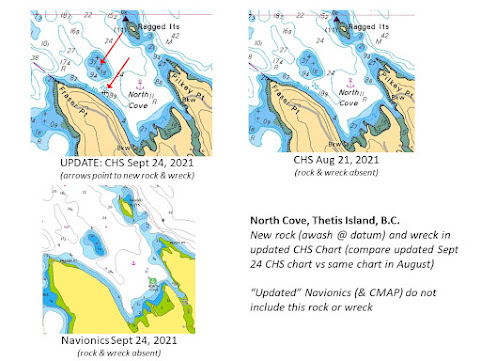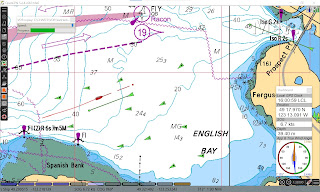UPDATE, March 26, 2024: revised version (adds UTC time to output; minor fixes) uploaded [NMEAtoXYZ-3c]
This post is part of a series concerning obtaining/creating more-detailed depth information.
Note: this particular post is technical and may not be of interest to some....
Entering an unfamiliar (and poorly charted*) bay, it would be nice to have a record of depths as we explore. In such cases, however, one must focus on safely navigating, rather than noting down or saving depths.
* In B.C., many bays and coves on up-to-date, decently charted areas often have only a few soundings.
OpenCPN Voyage Data Recorder
Our GPS, AIS, and depth/wind/speed information are now available via WIFI for use by our ship's computer and Android tablet running OpenCPN chartplotting software. OpenCPN is fantastic. Among its many free plugins is the "Voyage Data Recorder", or VDR. When VDR is set to "record", it saves all the NMEA sentence information (including AIS, latitude, longitude, depth, etc) into a text file, until the recording is stopped. A short example of a NMEA text file is shown below:
 |
Sample section of a NMEA text file
|
In the above sample, !AIVDMs are NMEA sentences for AIS info, $IIDPTs are depths, $IIMWVs are wind, $GPVTGs are speed and course over ground, and $GPRMC, $GPGGA, $GPGLL sentences provide GPS location (Lat/Lon), time, date, course and other GPS information.
The depth information in a NMEA text file does not contain location (Lat/Lon) info. However, there is always such information within less than a second of the depth sentence. We have written a short program to associate NMEA depth info with location, and to save these depth points into two types of files. NMEAtoXYZ is a simple program for Windows PCs that inputs a NMEA text file, and outputs (i) a GPX file of depth waypoints, and (ii) an XYZ file of the same points. The program gives the user the option to correct depths for tide level (recommended), and to determine the spacing (in time, thus distance) between depths. #
A GPX file can be imported into any GPS or chartplotter. The XYZ file can be used by software to produce satellite image chartfiles WITH depths plotted (see below).
The following screenshots show the process and output:
Playback of VDR recording in English Bay. Pelagia is shown as the red boat with a red trail. [The green triangles represent AIS broadcasted from anchored (black dot) and moving (with line of projected course in front) ships.]
Zoom in on Pelagia (with Tug & Tow heading in opposite direction)
NMEAtoXYZ-3a: GPX output
 |
Depth waypoints (S2Z22 highlighted) saved to GPX by NMEAtoXYZ program
|
Waypoints are coded in two ways: Arrow symbol and 1st two characters of waypoint name
S2xxxx: Magenta arrow: Depth >20m
S1xxxx: Blue arrow: Depth >2m to 20m
S0xxxx: Red arrow: Depth ≤2M
The symbols are specific to OpenCPN; the waypoint name will work with all GPSs and chartplotters
NMEAtoXYZ-3a: XYZ output
Using SASPLANET and SAT2CHART programs, the XYZ file's depths may be plotted on to a satellite image of the area. This image may then be displayed as a "chart" on OpenCPN. (Full details are explained in SAT2CHART's HELP pages.)
 |
| Satellite image chart with depths |
|
The number of depths points plotted by SAT2CHART depend on the zoom factor (higher zooms = more points, when available)
One may also plot these depths on (i) an image of a Navionics chart (using SASPLANET & SAT2CHART) or (ii) on an existing raster chart using a GIS program such as QGIS.
 |
Depths plotted on CHS chart (using QGIS)
|
The above examples are from Vancouver Harbour. Obviously, such a well-charted place does not require one to be saving depths and making image charts with depths are not required (it's just a test example).
However...
British Columbia still has some areas where nautical charts contain NO depth soundings (for example, parts of the West coast of Haida Gwaii). Even more common, many bays and coves in BC, even in Southern BC, have very limited depth details. A good example is the entrance to Von Donop Inlet/Ha'thayim Marine Park, which we described in a recent post.
As we cruise this coming Summer, we hope to obtain more-detailed depth information for the places we visit using (i) the VDR feature of OpenCPN and the above programs, as well as (ii) more-detailed scans using our Deeper Pro+ portable sounder.
The NMEAtoXYZ program (with helpfile) is available free to download from the following link (USE AT YOUR OWN RISK!):
Download latest program update from this link:
https://drive.google.com/file/d/1-YGVXu7k-fYrXD9hWwD5g1E3f5U3m2q8/view?usp=sharing
Note, it has only been tested on a PC running Windows (it MAY work on Linux and MacOS, but these have not been tested). It is a very simple program (written using QB64), currently with no GUI. NMEA VDR file plugin and OpenCPN are available for most platforms, except those running iOS.
# FYI: Reefmaster is commercial software (US$200) that also will save depths with lat/lon, plus a lot more.























